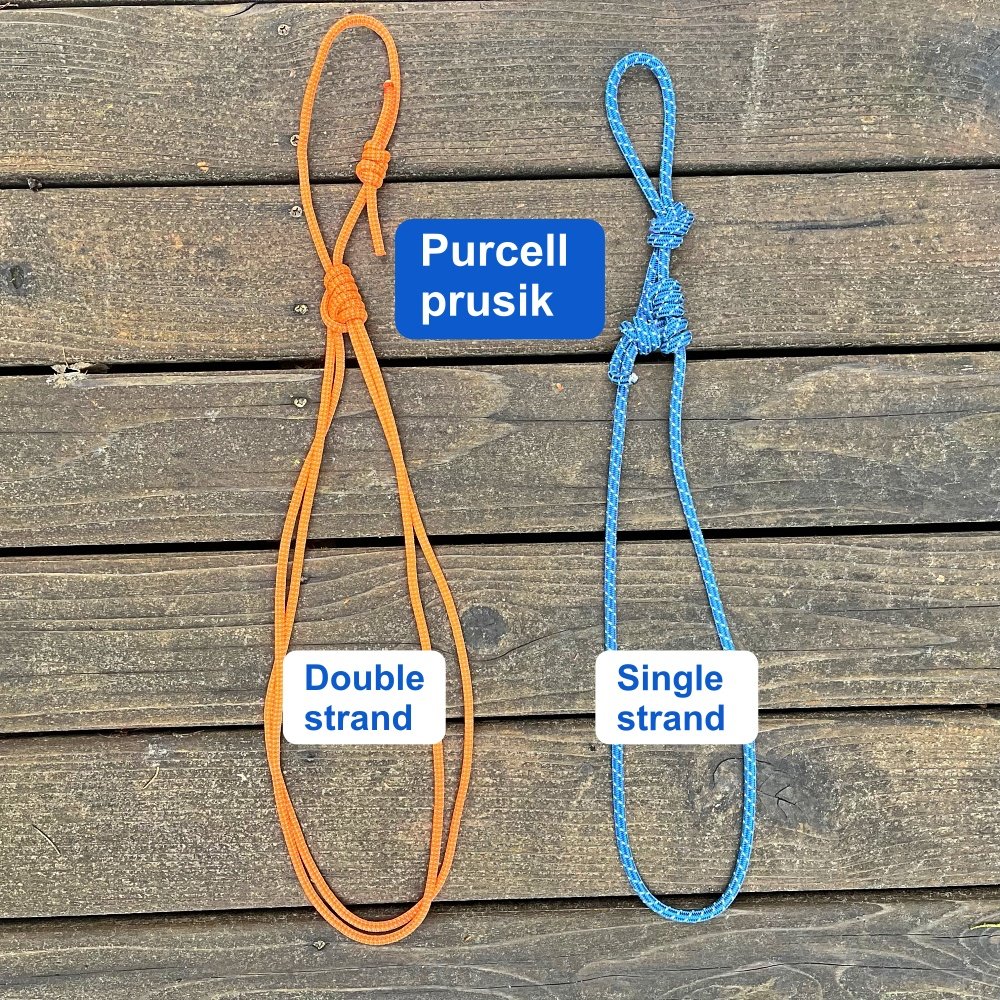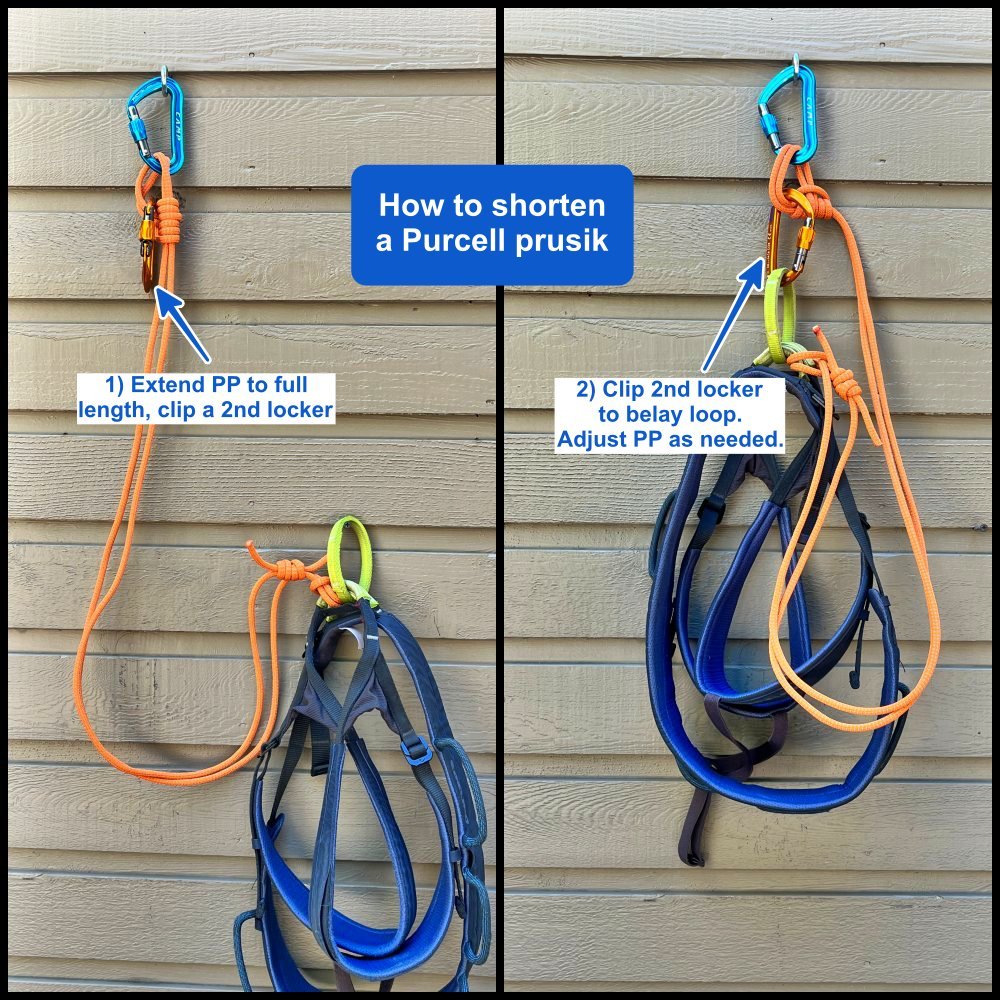Single strand Purcell Prusik
This Crafty Rope Trick comes from my canyoneering expert buddy Kevin Clark. Check out Kevin's book, “Canyoning in the Pacific Northwest”. Kevin learned it from Ben Lewis, a canyoning expert who made the video at the bottom. Thanks, Kevin and Ben!
The Purcell prusik is named after the Purcell Mountains of British Columbia Canada, and was invented in the 1990s by Canadian IFMGA Guide and rigging expert Kirk Mauthner.
The Purcell prusik is an interesting, sometimes useful, and sort of klunky bit of ropecraft.
Tied in the usual way, it consists of a prusik hitch sort of tied back onto itself to make an double strand adjustable loop. (The method shown here is a bit different than how it was first introduced.)
This has a few applications in self rescue, rope ascending, rigging mechanical advantage systems, adjusting rescue litters, and impressing your knot-nerd pals. One useful feature is that it can be extended under load, which makes it handy for knot passing and other rescue-type stuff. Plus, it’s inexpensive.
But it has a few downsides:
it’s bulky
the twin loops tangle easily
you need two hands to shorten it
it only adjusts from full length to half length (unless you know a certain #CraftyRopeTrick, see below)
Some climbers use the Purcell prusik as a personal tether or ice ax leash or something similar. But the hassles listed here mean it’s not part of everyday gear for most people. (If you want an adjustable tether, a more modern approach is something like the Petzl Connect Adjust, or a DIY version, the Kong Slyde.)
Here’s an interesting variation: the single strand Purcell prusik.
Because it’s tied on a single strand, it’s lighter, lower bulk and less tangle prone than the regular double strand version. (It still has the downsides of only adjusting from full length to half length, and needing two hands to shorten it,)
You could use a few different materials to tie it. 6 mm accessory cord works for things like an ice ax tether, or some connection that’s not going to be taking much force. Remember, 6 mm cord is rated to about 7.5 kN, and when knotted, it’s going to be about half that, more like 4 kN, so it’s probably not something you want as a load bearing anchor. (But 7 mm cord is rated to a stout 13 kN, that’s an option too.)
Here’s a single strand Purcell prusik made with about 8 feet of 7mm cord. Much more stout at 13 kN, fine for anchoring.
If you want light and strong, you can tie it with Sterling PowerCord, a svelte cord at just 5.9 mm with a Technora core that’s is rated to a burly 18 kN, plenty strong enough for a serious anchor even with a knot in one end.
Side note: PowerCord is a great choice for a cordelette.
Lots of people think that one of the main problems with the Purcell prusik is that you can never get it any shorter than half the length. So, how do you stay clipped in very close to something?
I thought this too for a long time, until I learned this #CraftyRopeTrick from my pal Ryan at HowNot2. He shows it the video at the bottom of this page. (The photo below is with a standard double strand, but it works the same way with a single strand.)
Extend your PP all the way, until there's just a tiny loop of rope at the end. Into this loop, clip a second locking carabiner.
Now, clip this second locker to your belay loop. Now you can clip just two carabiner lengths to anything. Plus, you can increase the size of this loop by feeding cord through, to adjust your distance as needed.
Kind of for fun, I also made a single strand Purcell prusik into a double tether, tied with about 14 feet of 6mm cord. Applications for this . . . ? Aid climbing tethers? Foot loops for ascending a rope? Maybe ice tool tethers? Doing rigging or rope work or routesetting and you have these attached to your tools, drill, bucket, whatever? I was experimenting and haven't used it in the real world, but give it a try and let me know how it works for you.
Now, I get it that lots of people don’t like to carry any kind of designated tether, and that’s fine. I’m putting this tip out there for people who might find it helpful. At the very least, it’s an interesting bit of knotcraft to play around with, so try it yourself and see how it works, even if you don’t think you’ll find a use for it.
Check out the video by Ben Lewis to learn how to tie it. (You’ll probably need to watch it a couple of times, hint hint.)
Finally, here's a nice video from our friends at HowNot2 that discuss how to tie the standard version, and some strength tests on it.





